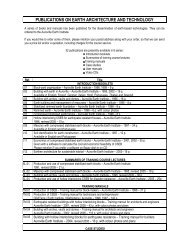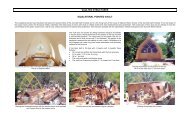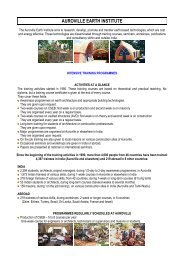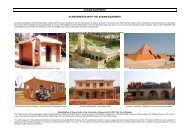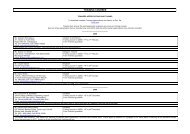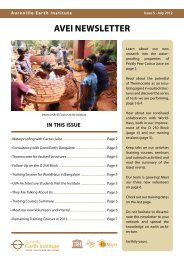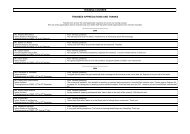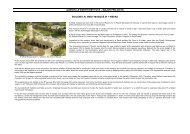auram equipment handling the auram press 3000 - Auroville Earth ...
auram equipment handling the auram press 3000 - Auroville Earth ...
auram equipment handling the auram press 3000 - Auroville Earth ...
Create successful ePaper yourself
Turn your PDF publications into a flip-book with our unique Google optimized e-Paper software.
AURAM EQUIPMENT<br />
HANDLING THE AURAM PRESS <strong>3000</strong><br />
The automatic opening of <strong>the</strong> Auram <strong>press</strong> <strong>3000</strong>, combined with <strong>the</strong> sliding hopper assures a higher productivity than o<strong>the</strong>r <strong>press</strong>es. The <strong>the</strong>oretical daily output is 1,000 blocks but one can expect practically 850<br />
blocks per day of plain blocks 240 or 290. The Auram <strong>press</strong> <strong>3000</strong>, beside its versatility, presents <strong>the</strong> advantage to give more regular quality blocks than o<strong>the</strong>r <strong>press</strong>es worldwide. The mould is all <strong>the</strong> daylong fed with<br />
<strong>the</strong> same quantity of mix soil, due to <strong>the</strong> sliding hopper. The productivity is also increased by <strong>the</strong> fact that <strong>the</strong> sliding hopper does two operations: When it slides above <strong>the</strong> mould, it pushes <strong>the</strong> block which had been<br />
com<strong>press</strong>ed earlier and <strong>the</strong>n <strong>the</strong> soil mix falls in <strong>the</strong> mould when <strong>the</strong> lever is pulled back up.<br />
The <strong>press</strong> requires a total number of 7 workers for <strong>the</strong> block production:<br />
• 3 People for mixing: They measure first <strong>the</strong> various components and deliver <strong>the</strong> materials to <strong>the</strong> block yard. Then <strong>the</strong>y mix first dry (minimum 2 times), add water and mix again minimum 2 times.<br />
• 1 Operator who feed <strong>the</strong> <strong>press</strong> with <strong>the</strong> hand shovel (Scoop) into <strong>the</strong> hopper. Then he slides <strong>the</strong> hopper above <strong>the</strong> mould and pushes it back. Finally he closes <strong>the</strong> lid. He checks <strong>the</strong> quality of blocks with <strong>the</strong><br />
pocket penetrometer and <strong>the</strong> block height gauge (delivered with <strong>the</strong> <strong>press</strong>). This checking is done only for <strong>the</strong> first block of every new mix. Time to time he has also to clean <strong>the</strong> corners of <strong>the</strong> mould and <strong>the</strong><br />
plates with <strong>the</strong> scraper delivered with <strong>the</strong> <strong>press</strong>.<br />
• 2 People on <strong>the</strong> lever for com<strong>press</strong>ing <strong>the</strong> mix. They first pull down <strong>the</strong> lever till <strong>the</strong> end of com<strong>press</strong>ion. In one single action, <strong>the</strong>y go ahead <strong>press</strong>ing down till <strong>the</strong> lid opens automatically with <strong>the</strong> chain system<br />
and <strong>the</strong>n <strong>press</strong> fur<strong>the</strong>r down to eject <strong>the</strong> block. Note that <strong>the</strong> <strong>press</strong> com<strong>press</strong>es with 15 tons force and it is usually not possible to <strong>press</strong> down <strong>the</strong> lever with a single man.<br />
• 1 person for stacking <strong>the</strong> block for <strong>the</strong> initial curing. This stacking is done near <strong>the</strong> <strong>press</strong>. He covers regularly <strong>the</strong> blocks with a plastic sheet so as to avoid any evaporation of <strong>the</strong> moisture of <strong>the</strong> mix.<br />
The Auram <strong>press</strong> <strong>3000</strong> is delivered with quality control devices:<br />
• A pocket penetrometer: to check <strong>the</strong> com<strong>press</strong>ion quality.<br />
The <strong>press</strong> <strong>3000</strong> gives most of <strong>the</strong> time higher com<strong>press</strong>ion than o<strong>the</strong>r manual <strong>press</strong>es and when <strong>the</strong> <strong>press</strong> is well adjusted for a good soil, <strong>the</strong> pocket penetrometer would penetrate only 2-3 mm in <strong>the</strong> block<br />
instead of <strong>the</strong> tolerable penetration of 6 mm.<br />
• A block height gauge: to check <strong>the</strong> block height.<br />
With <strong>the</strong> micro adjustment of <strong>the</strong> block height, <strong>the</strong> <strong>press</strong> <strong>3000</strong> can insure high accuracy of <strong>the</strong> height (~ 0.5 mm), which is essential for interlocking blocks or blocks which are used for arches, vaults and domes.<br />
Note that <strong>the</strong> pocket penetrometer and <strong>the</strong> block height gauge are also indicators for <strong>the</strong> moisture content in <strong>the</strong> mix<br />
Once <strong>the</strong> <strong>press</strong> has been adjusted properly according to <strong>the</strong> soil, any variation with <strong>the</strong> pocket penetrometer and/or <strong>the</strong> block height gauge will mean <strong>the</strong> following:<br />
• When <strong>the</strong> pocket penetrometer penetrates <strong>the</strong> block more than usual, <strong>the</strong> moisture content is higher than normal. Thus <strong>the</strong> moisture content of <strong>the</strong> mix has to be corrected for <strong>the</strong> next batches and <strong>the</strong> <strong>press</strong> should<br />
not be touched.<br />
• On <strong>the</strong> opposite side, when <strong>the</strong> pocket penetrometer penetrates less into <strong>the</strong> block, it means that <strong>the</strong> mix is too dry. The next batches of mix should be moister and <strong>the</strong> <strong>press</strong> should not be touched.<br />
• When <strong>the</strong> block height is more than usual, <strong>the</strong> moisture content is dryer than normal. Then add more water for <strong>the</strong> next mixes.<br />
• On <strong>the</strong> opposite side, when <strong>the</strong> block height is less than usual, it means that <strong>the</strong> mix is too wet. Add less water for <strong>the</strong> next mixes.<br />
Basic process of block making<br />
Click here to download
Opening <strong>the</strong> lid of <strong>the</strong> <strong>press</strong> by pulling <strong>the</strong> handle<br />
Sliding <strong>the</strong> hopper above <strong>the</strong> mould<br />
Starting <strong>the</strong> com<strong>press</strong>ion, while <strong>the</strong> operator fills <strong>the</strong> scoop<br />
Automatic opening of <strong>the</strong> lid<br />
Pushing back <strong>the</strong> hopper to level <strong>the</strong> soil in <strong>the</strong> mould<br />
Pulling down <strong>the</strong> lever, while <strong>the</strong> operator supplies <strong>the</strong> mix<br />
Feeding <strong>the</strong> <strong>press</strong> with <strong>the</strong> scoop into <strong>the</strong> hopper<br />
Closing <strong>the</strong> lid<br />
Automatic opening of <strong>the</strong> lid, while <strong>the</strong> operator fills <strong>the</strong> hopper
Ejection of <strong>the</strong> block, while <strong>the</strong> operator fills <strong>the</strong> hopper<br />
Checking <strong>the</strong> block height with <strong>the</strong> block height gauge<br />
(Only for <strong>the</strong> first block of every new mix)<br />
Scraping regularly <strong>the</strong> bottom plate with <strong>the</strong> scraper<br />
Checking <strong>the</strong> quality of com<strong>press</strong>ion with <strong>the</strong> pocket penetrometer<br />
(Only for <strong>the</strong> first block of every new mix)<br />
Handling <strong>the</strong> block to stack it near <strong>the</strong> <strong>press</strong> for <strong>the</strong> initial curing<br />
Cleaning occasionally <strong>the</strong> corners of <strong>the</strong> mould with <strong>the</strong> scraper<br />
Sliding <strong>the</strong> hopper to push <strong>the</strong> block and to fill <strong>the</strong> mix into <strong>the</strong> mould<br />
Brushing time to time <strong>the</strong> table with a brush<br />
Brushing time to time <strong>the</strong> top plate with <strong>the</strong> wire brush





